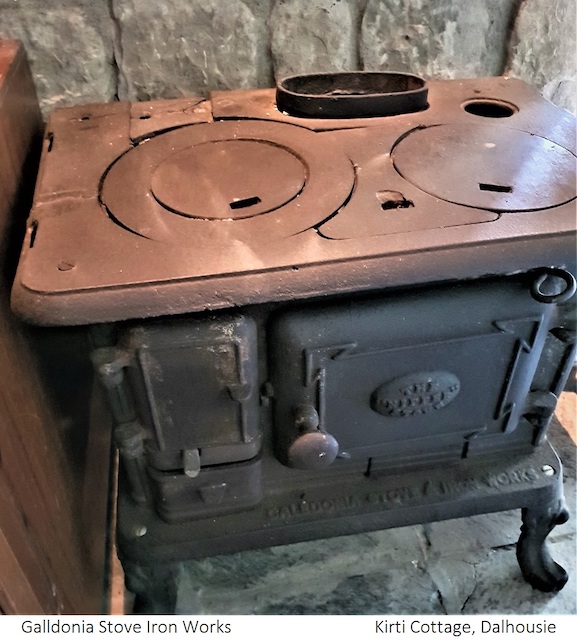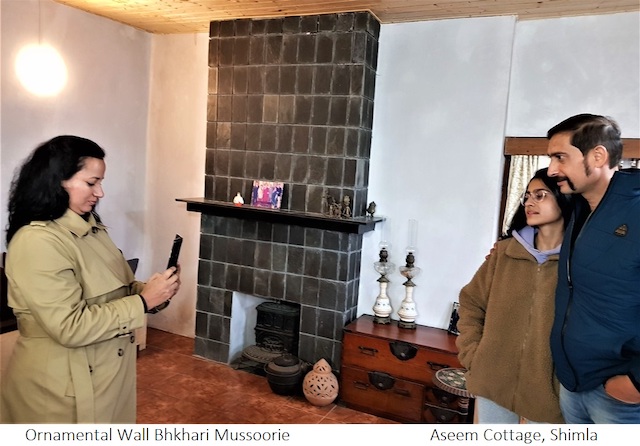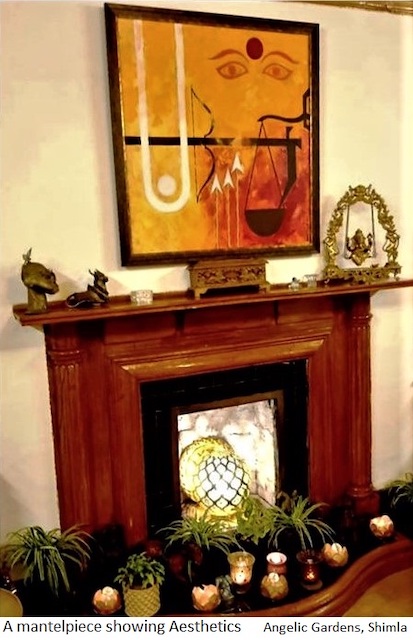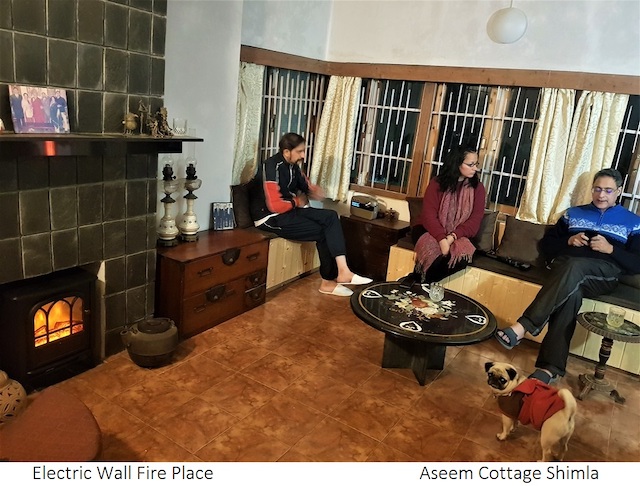Ancient fire pits were sometimes built in the ground, within caves, or in the center of a hut or dwelling.

Fireplaces are used for the relaxing ambiance they create and for heating a room. The structures are made of brick, stone, metal or other materials designed to contain a fire.
Historically they were used for heating a dwelling, cooking, and heating water for laundry and domestic uses. The fireplaces of the Victorian era were thought to add a cosy ambiance to homes as well as providing heat. They also served as a gathering place within the home.
Bukhari is a traditional space heater from the northern areas of the Indian subcontinent, which is typically a wood-burning stove. Bukharis consist of a wide cylindrical fire-chamber at the base in which wood, charcoal or other fuel is burned and a narrower cylinder on the top that helps in heating the room and acts as a chimney.
- On our 17th wedding anniversary, I got a custom made cast iron bukhari from Nahan Foundry*, with a special embossing W A C P V 1985 (Chander Parkash Vishav Kirti)
- Most fireplaces are made up of two parts, the surround and the insert. The surround consists of the mantelpiece and side supports, usually in wood, marble or granite. The insert is where the fire burns, and is constructed of cast iron often backed with decorative tiles.
Usually, a fireplace may have the following:
- A foundation, a hearth, a firebox, a mantelpiece; a grate , a lintel, a lintel bar, a damper, a smoke chamber, a throat(waist), a flue, and a chimney filter.
- On the exterior there is often a corbelled brick crown, to keep rainwater from running down the exterior walls. Cap and a spark arrestor at the top to keep small animals out and to prevent sparks and burning embers from being splintered out into the atmosphere.
- To beat the cold of 2007 of Shimla, we joined our son Manu Maharaaj at Patna but to our dismay, there it felt colder. Fire places of the ‘City S P’s residence’ of British times, were yet choked with their spark arresters blocked for fear of showing up of animals of the lizard(goh) family. Meenakshi managed to put them back to functioning and we enjoyed the warmth.
- There is an area called the smoke chamber. Its function is to safely move smoke and hot gases from the throat of fireplace to the narrow flue of the chimney.
- A grate (or fire grate) is a frame, usually of iron bars, to retain fuel for a fire.
- A built of refractory bricks, absorbs the heat. This heat is then evenly radiated for many hours during the second phase.
- Fire backs are traditionally made from cast iron to capture and re-radiate heat, to protect the back of the fireplace, and as decoration. It also increases the fireplace efficiency.
- Fenders are low metal frames set in front of the fireplace to contain embers, soot and ash. Smoke canopies prevent smoke from spreading through a room and vent it out through a wall or roof.
- Chimneys give the fireplace a draft, and also make it possible to put fireplaces in multiple rooms in buildings conveniently. The chimney or flue gases must be hotter than the outside temperature to ensure that the combustion gases are drawn out of the fire chamber and up the chimney.
- Keeping the air flowing correctly through a wood-burning stove is essential for safe and efficient operation of the stove. To regulate air flow, there may be damper devices built into the stove, flue, and stove pipes.
- Fresh air needs to enter the firebox to provide oxygen for the fire; as the fire burns, the smoke must be allowed to rise through the stove pipe, and exit through the chimney. By opening or closing the dampers, air flow can be increased or decreased, which can fan the fire in the firebox, or “dampen” it by restricting airflow and reducing the flames. The dampers can usually be accessed by turning knobs or handles attached to the damper.
- Many modern stoves can optionally use an outside air intake. Many manufacturers supply the necessary parts in kit form (an Outside Air Kit, or OAK). When considering an outside air kit, it is important to know that the air must come in from below the level of the stove.
- For fireplace tending; tools include pokers, bellows, tongs, shovels, brushes and tool stands. Accessories may include log baskets, coal buckets and more.
- Over time, the purpose of fireplaces has changed from one of necessity to one of visual interest; Aesthetics, Arts and Crafts. Emphasis is placed on providing wall décor with quality stone; notionally considered a symbol of prosperity.
A piece of hardwood would usually be heavier and have more available energy than the same sized piece of softwood. Hardwoods are ideal for long, low burns. Softwoods, in contrast, tend to burn hot and fast with little coaling. Sawdust bricks are another option.
- In Noida, the open air fireplace on the terrace of Aman Bajaj, some special wood log bits make an exclusive camp fire.
- The safe operation of a wood-burning stove requires regular maintenance such as emptying ash pans (containers) beneath the wood grate. Routine cleaning of the stove pipes and chimney is also needed to prevent chimney fires.
- Under the United Kingdom’s Clean Air Act, It is an offence to emit smoke from a chimney of a building, in order to comply with the Clean Air Act in “smoke control areas”,
- Correct air flow and ventilation are also critical to efficient and safe wood burning.
- Oxygen sensor and carbon monoxide sensors are safety essentials.
- The cutting of large amounts of firewood also endangers local forests and ecosystems.
- Forest conservation imperatives have resulted in the development of alternative designs for bukharis in India, including kerosene-based versions and bukharis that are more fuel-efficient than the traditional varieties. Gas-powered fireplaces and Electric fireplaces are now common substitutes.
- A decision taken 22 years ago to ban the use of coal heaters in the offices and residential buildings of Shimla town has brought in positive results, with a marked improvement in the hill town’s air quality.
- We have also replaced our ‘wood burning bukhari’ with an electric fireplace in our Shimla cottage.
The United States Environmental Protection Agency (EPA) writes “Smoke may smell good, but it’s not good for you.”
………………………………………………………………………………………………………………………………………………..* Current status of Nahan Foundry Limited is – Amalgamated.
Prof. (Er.) Chander P Mahajan is an art critic & a free lance journalist. The Environmentalist stays in Shimla and Dalhousie, Himachal Pradesh, India.








